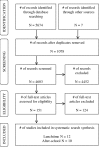Correlates of children's time-specific physical activity: a review of the literature
- PMID: 22546218
- PMCID: PMC3441809
- DOI: 10.1186/1479-5868-9-50
Correlates of children's time-specific physical activity: a review of the literature
Abstract
Assessment of correlates of physical activity occurring at different times of the day, locations and contexts, is imperative to understanding children's physical activity behaviour. The purpose of this review was to identify the correlates of children's physical activity (aged 8-14 years) occurring during the school break time and after-school periods. A review was conducted of the peer-reviewed literature, published between 1990 and January 2011. A total of 22 studies (12 school break time studies, 10 after-school studies) were included in the review. Across the 22 studies, 17 studies were cross-sectional and five studies were interventions. In the school break time studies, 39 potential correlates were identified, of which gender and age were consistently associated with school break time physical activity in two or more studies, and family affluence, access to a gym, access to four or more physical activity programs and the condition of a playing field were all associated with school break time physical activity in only one study. Access to loose and fixed equipment, playground markings, size of and access to play space and the length of school break time were all positively associated with changes in school break time physical activity in intervention studies. Thirty-six potential correlates of after-school physical activity were identified. Gender (with boys more active), younger age, lower body mass index (for females), lower TV viewing/playing video games, and greater access to facilities were associated with higher levels of after-school physical activity in two or more studies. Parent supervision was negatively associated with females' after-school physical activity in one study. This review has revealed a relatively small number of studies investigating the school break time and after-school periods in the specified age range and only a few correlates have demonstrated a consistent association with physical activity. This highlights the infancy of this area and a need for further investigation into time-specific physical activity behaviour so that interventions designed for these specific periods can target the important correlates.
References
-
- Sallis JF, Prochaska JJ, Taylor WC, Hill JO, Geraci JC. Correlates of physical activity in a national sample of girls and boys in Grades 4 through 12. Health Psychol. 1999;18:410–415. - PubMed
-
- Harten N. The impact of spatial density and the configuration of space on children's movement. University of South Australia, School of Health Sciences; 2005.
Publication types
MeSH terms
LinkOut - more resources
Full Text Sources


